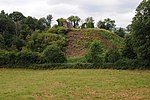Westbrook railway station (England)
Disused railway stations in HerefordshireFormer Great Western Railway stationsPages with no open date in Infobox stationRailway stations in Great Britain closed in 1950Railway stations in Great Britain opened in 1881 ... and 2 more
Use British English from November 2022West Midlands (region) railway station stubs
Westbrook railway station was a station to the northwest of Dorstone, Herefordshire, England. The station was opened in 1881, closed to passengers in 1941 and closed completely in 1950.
Excerpt from the Wikipedia article Westbrook railway station (England) (License: CC BY-SA 3.0, Authors).Westbrook railway station (England)
The Firs,
Geographical coordinates (GPS) Address External links Nearby Places Show on map
Geographical coordinates (GPS)
| Latitude | Longitude |
|---|---|
| N 52.0864 ° | E -3.0497 ° |
Address
Westbrook
The Firs
HR3 5SY
England, United Kingdom
Open on Google Maps




